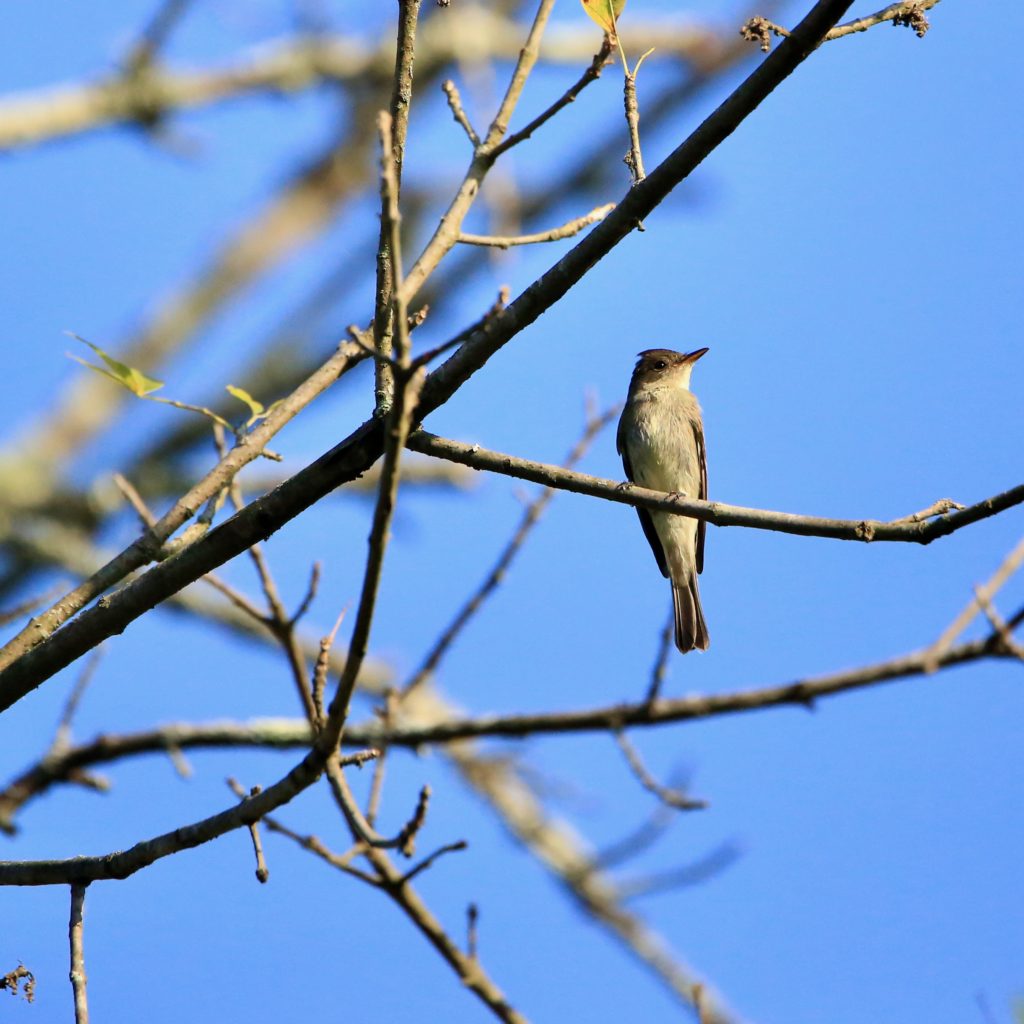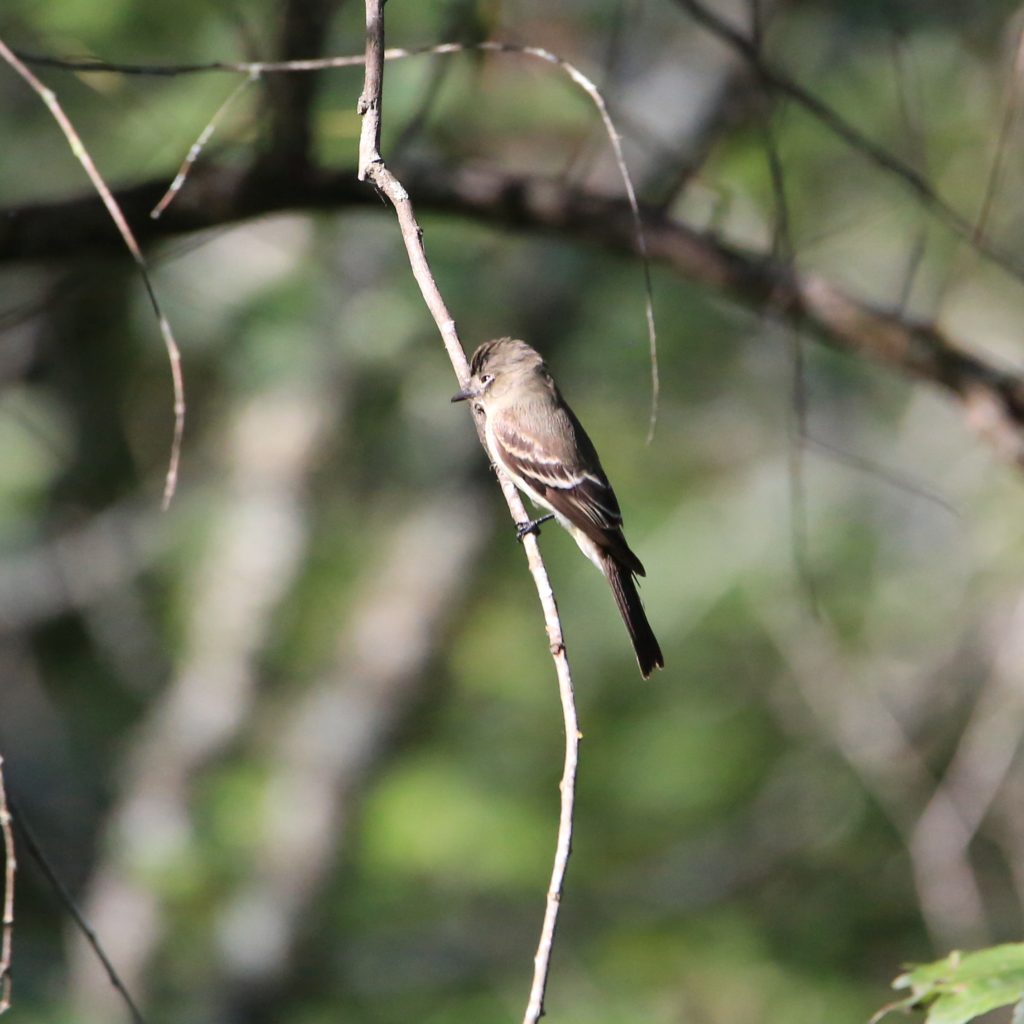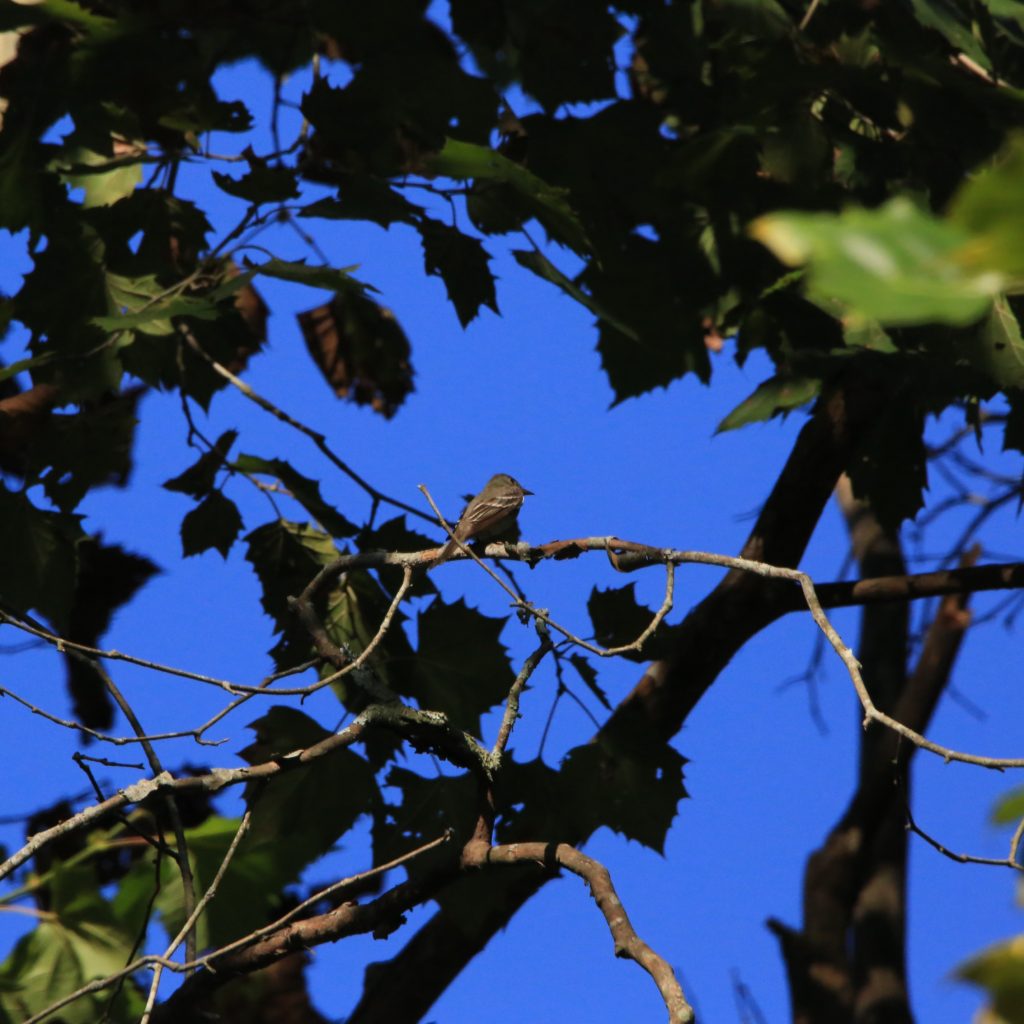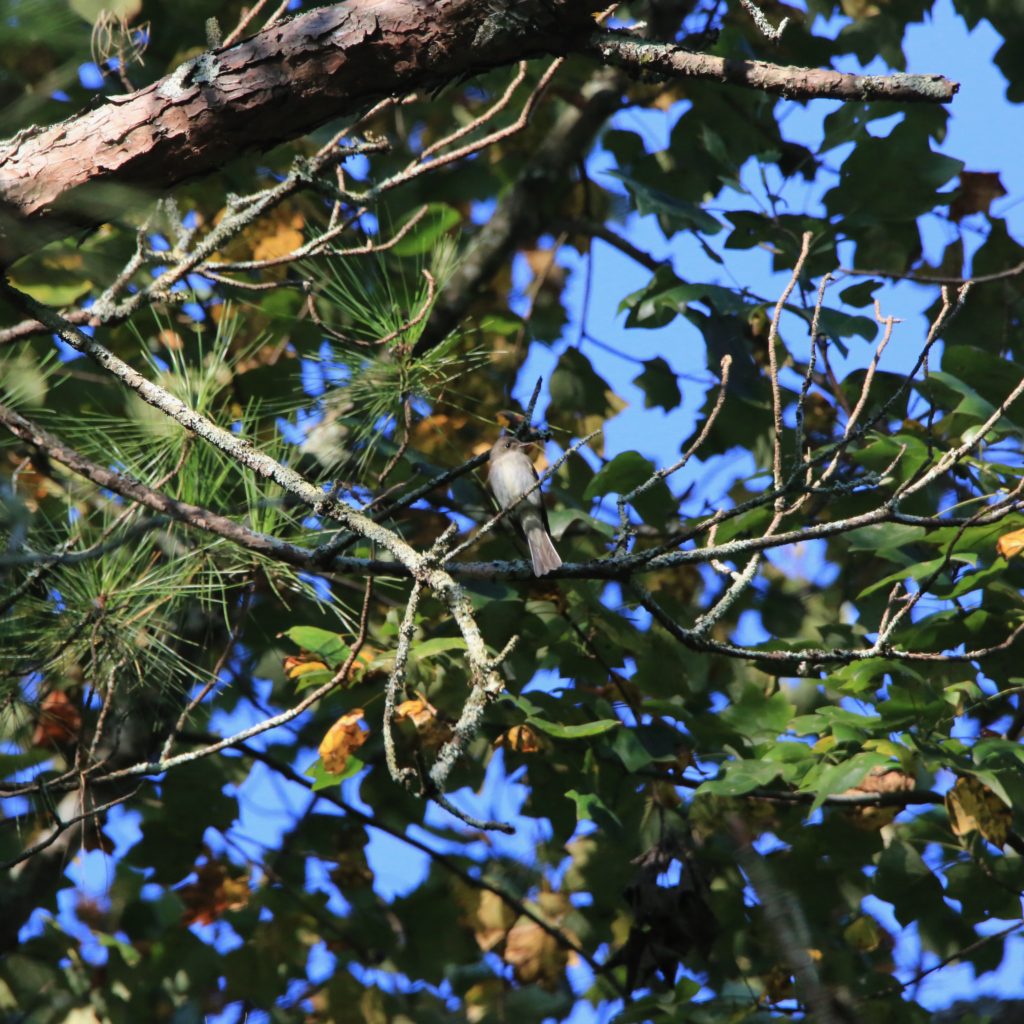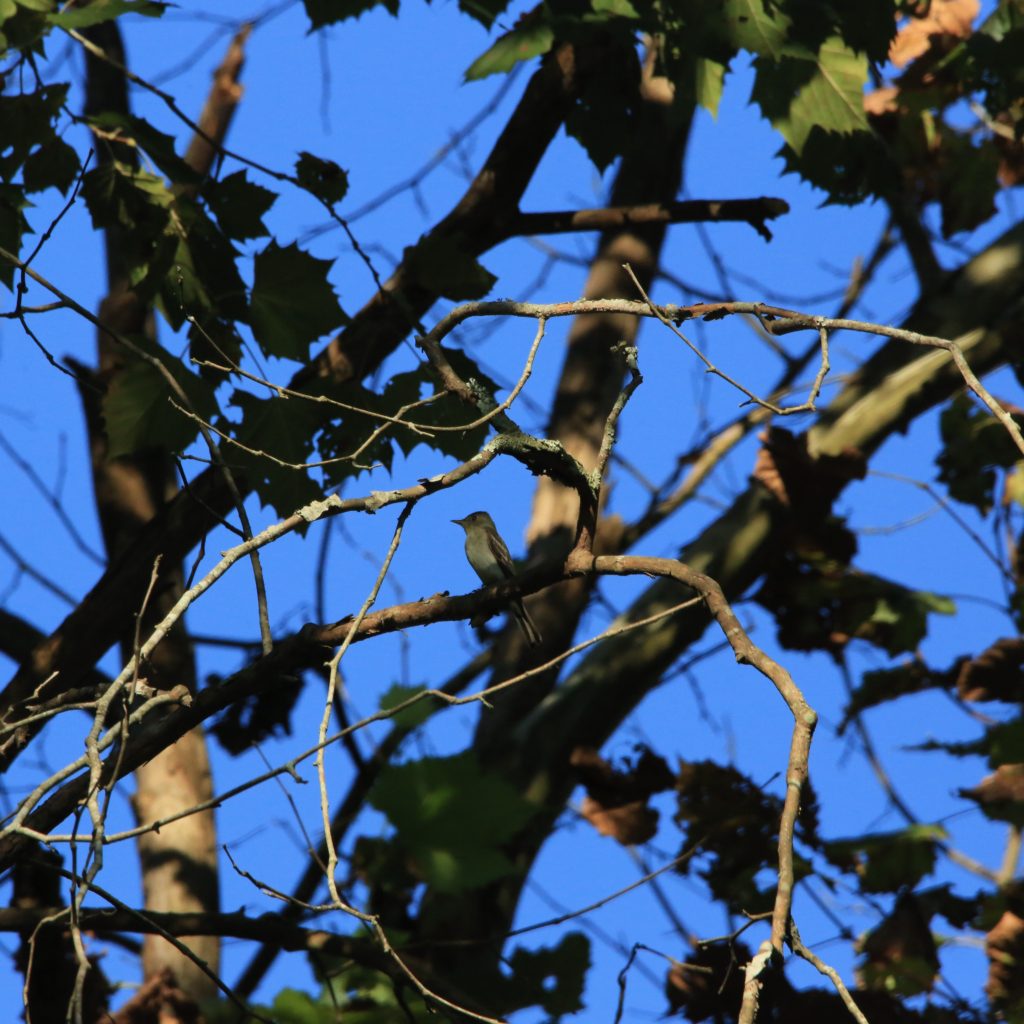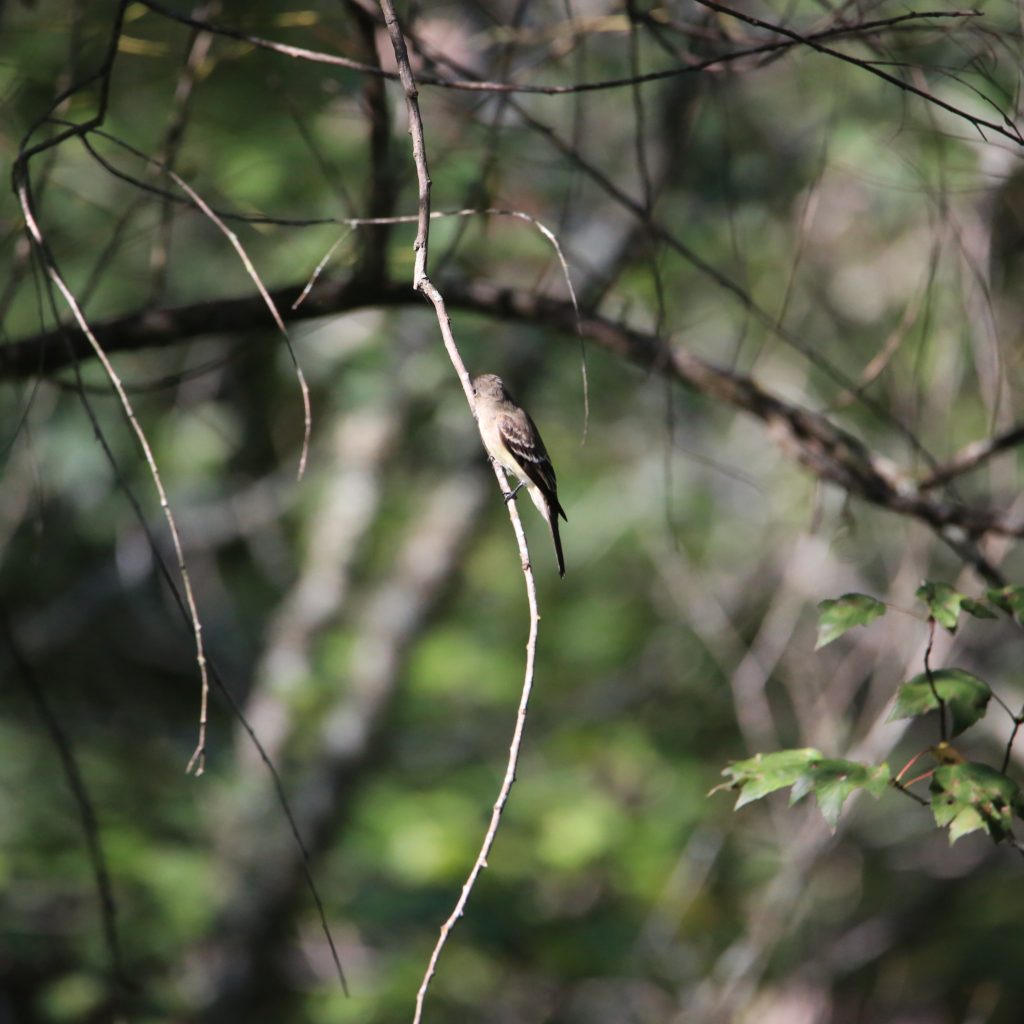
The Eastern Wood-Pewee is a small Flycatcher best known for its distinctive songs. Pee-ah-wee. This song has earned them their name. This song is a common occurrence in the wooded habitats of the Eastern U.S. and southern Canada in the summer months. For quite a long time, this species has been very difficult to study, because their nests aren’t easy to find. They look like a knot on a branch. As a result of these inaccessible nests, researchers have just recently been able to study the reproductive biology of this species.
About Eastern Wood-Pewees
These birds grow so accustomed to the habitats in their wintering ranges that they are one of the migratory birds to depart from their wintering habitat. Eastern Wood-Pewees stay in the forest amongst many other Flycatcher species such as the Great Crested Flycatcher, Acadian Flycatcher, and Least Flycatcher.
Eastern Wood-Pewees are almost completely identical to Western Wood-Pewees. Even the most experienced birders find it hard to distinguish these birds solely based on their appearance. Their vocalizations are hard to recognize, making it difficult to identify these birds. Another way of differentiating them is by studying their range. These two species only have a range overlap in a short area in the Great Plains. There is no evidence to suggest that these birds interbreed.
Eastern Wood-Pewee populations are still very common throughout their range, but steadily their populations have been declining. There has been a pretty significant decline in the past 50 years. This decline is mainly a result of the loss of their overwintering habitats. There has also been a tremendous loss of their stopover habitats which is further
burdening the strength of these birds.
Some other factors are also contributing to the decline of the numbers of these birds. The use of insecticides is reducing the abundance of important food for them such as arthropods. Other than that, animals such as White-tailed Deer disturb their habitat by grazing heavily.
As Eastern Wood-Pewees look similar to other species such as the Tropical Pewee and the Western Wood-Pewee, it is difficult to correctly identify their overwintering ranges. Don’t these Flycatchers seem interesting? Let’s learn more about them.
● Eastern Wood-Pewees Photos, Color Pattern, Song
● Eastern Wood-Pewees Size, Eating behavior, Habitat
● Eastern Wood-Pewees Range and Migration, Nesting
GET KIDS BIRD WATCHING
Eastern Wood-Pewees Color Pattern
The plumage of Eastern Wood-Pewees is mostly olive-brown in color. Their upper parts are grayish olive with a slightly darker crown and nape. Their tail feathers are mostly between dark brown and black in color. They might have a narrow white eye ring and some other white feather in the facial region. Except for the lesser coverts of their upper wings, the rest of the upper wing feathers are dark brown or dusky. The lesser coverts are olive or grayish-olive. The gray tips on their tail feathers form a number of wing bars.
Eastern Wood-Pewees have light gray or white throats and bellies, and their chests are olive to gray in color. The chest band areas of these birds might differ per individual, but mostly there’s usually a split in the center. The underwings are mostly gray with a pale grayish or yellowish tint.
Both males and females have similar plumages. Juvenile Eastern Wood-Pewees have slightly darker and duller colors than the adults.
Description And Identification
Eastern Wood-Pewees are very similar to Western Wood-Pewees in appearance, but these two species are easier to recognize through their songs. Other calls except their songs might not be as different. These two species also have a few differences in the color of their plumages, but in the case of a range overlap these factors might not be as reliable.
Usually, Eastern Wood-Pewees have paler upperparts that may be a tinge green. The chests and sides of Western Wood-Pewees are also generally darker. Eastern Wood-Pewees might have a greenish tinge on their chest band, this is something that you can’t find on a Western Wood-Pewee.
Eastern Wood-Pewees also share a few similarities with other Flycatchers, but they are easier to recognize when around these birds. These birds are larger than Empidonax Flycatchers. They have a darker face, a less prominent eye-ring, and longer wings. From Eastern Phoebes, they can be differentiated through their smaller size, wing-bars, and
through the absence of tail-wagging behavior. Olive-sided Flycatchers also share a number of similarities with Eastern Wood-Pewees, but they can be differentiated through their smaller size, smaller head and bill in proportion to their body, brown flanks, and through the difference in the vocalizations of these birds.
One other species that is quite similar to Eastern Wood-Pewees and often overlaps with them is Tropical Pewees. As these birds have some very minute differences in their plumage, these birds might be impossible to differentiate in the field just on the basis of their physical appearance. In this case, observing their calls or songs would be a better way of distinguishing these species.
Eastern Wood-Pewee Song
Based on inconclusive evidence, it seems like Eastern Wood-Pewees are capable of improving and perfecting their song as they age. This research was conducted on unmarked birds.
Their song is a combination of 3 different units of the song. They perform these song units for long periods of time with an interval of a few seconds in the middle. The first song form is a slurred pee-ah-wee which generally lasts for about 1 second. The second song form is a plain “wee-ur” or “wee-ooo”. This one also lasts for only 1 second. Generally, Eastern Wood-Pewees sing these songs throughout the day, but most of the singing has come to a halt from dawn till late morning.
The patterns and intervals between songs 1 and 2 contain social information about these birds that they are sharing with others. Using this information, we can better understand the personality of the bird, i.e. is he a lone forager or an individual communicating with his mate.
The third song form is a slurred ah di dee which is sung in addition to the first two song forms during evenings and right before dawn. When this song is sung during the evening, it is called the twilight song.
You can use the distinct songs of individual Eastern Wood-Pewees to distinguish between them. When 20 males were studied, significant individual variations could be observed in each of them. Further studies need to be conducted to understand this behavior better.
Eastern Wood-Pewees also vocalize a number of other calls. When something disturbs a pair at the nest, they make a rapid “p-e-e-e-e-e” alarm. This vocalization is apparently also very important and prominent when the female builds the nest and incubates the eggs. These birds make short, twitters when they are mating, or courting each other. And when males are displaying territorial behavior, they vocalize a sequence of chips and squeaks. Young fledged Eastern Wood-Pewees make churr call.
Eastern Wood-Pewee Size
Eastern Wood-Pewees are small tyrant Flycatchers. They are 5.3-5.9 inches long, and they generally weigh 0.49 oz on average. Their wingspan is between 9.1-10.2 inches. Both males and females are of the same size.
Eastern Wood-Pewee Behavior
These Flycatchers are territorial birds that hold small territories. These territories can range between 5-20 acres. Eastern Wood-Pewees are not territorial during winter, during winter they can mix freely with other species, but they are often solitary.
These birds are very active singers during the day. Their singing bouts begin about an hour before daytime and continue throughout the day. Night-singing is also not uncommon. Female Eastern Wood-Pewees do not sing as regularly as the males, although they might respond to singing from other birds of their species. Males attack or chase other birds when they approach them while they are singing. In case other bird species are singing, these birds often pause and wait till they finish singing.
When Eastern Wood-Pewees sing during twilight, they have a fixed perch, daytime singing can occur in a number of different locations.
Eastern Wood-Pewees are monogamous birds. Both males and females partake in the responsibility of taking care of their nests, males bring food while the female incubates the eggs.
What Eastern Wood-Pewees Eat
Eastern Wood-Pewees are insectivorous birds that mainly prey on flying incests by sallying from a perch. Occasionally, they also forage on the ground.
Their perches are mostly dead branches located in the canopy or the sub-canopy. On average, they feed at an elevation of 36 feet. The insects they eat are stoneflies, mayflies, bees, moths, butterflies, true bugs, flies, and beetles. Sometimes they might also include dragonflies and spiders.
Vegetable matter makes up a small portion of their diet. This may include raspberries, blueberries, poison ivy, and berries and seeds.
The feeding habits of Eastern Wood-Pewees don’t vary much according to seasons. Younglings of these birds only consume insects.
Eastern Wood-Pewee Habitat
Eastern Wood-Pewees are Flycatchers that generally prefer being away from dense forest cover. Instead, they situate themselves in forest edges and clearings. They aren’t very choosy about their breeding habitat, most wooded habitats are suitable for them. These can include urban shade trees, woodlots, orchards, and roadsides. Most populations are life in deciduous forests, but they also merrily inhabit open pine woodlands and mixed conifer-hardwood forests.
In most of the eastern region, they occupy they generally avoid streams, but in the Great Plains, they often reside riverside. Their migration and wintering habitats can also include shrubby regions.
Winter habitats are usually in partially clear woodlands. In several regions, they nest in areas 4,000 feet off the ground. This elevation is not applicable to all the populations of Eastern Wood-Pewees.
In coniferous forests, they mostly prefer trees such as beech-maples, pine-aspens, aspen-red maples, and cedar-aspens.
Range and Migration
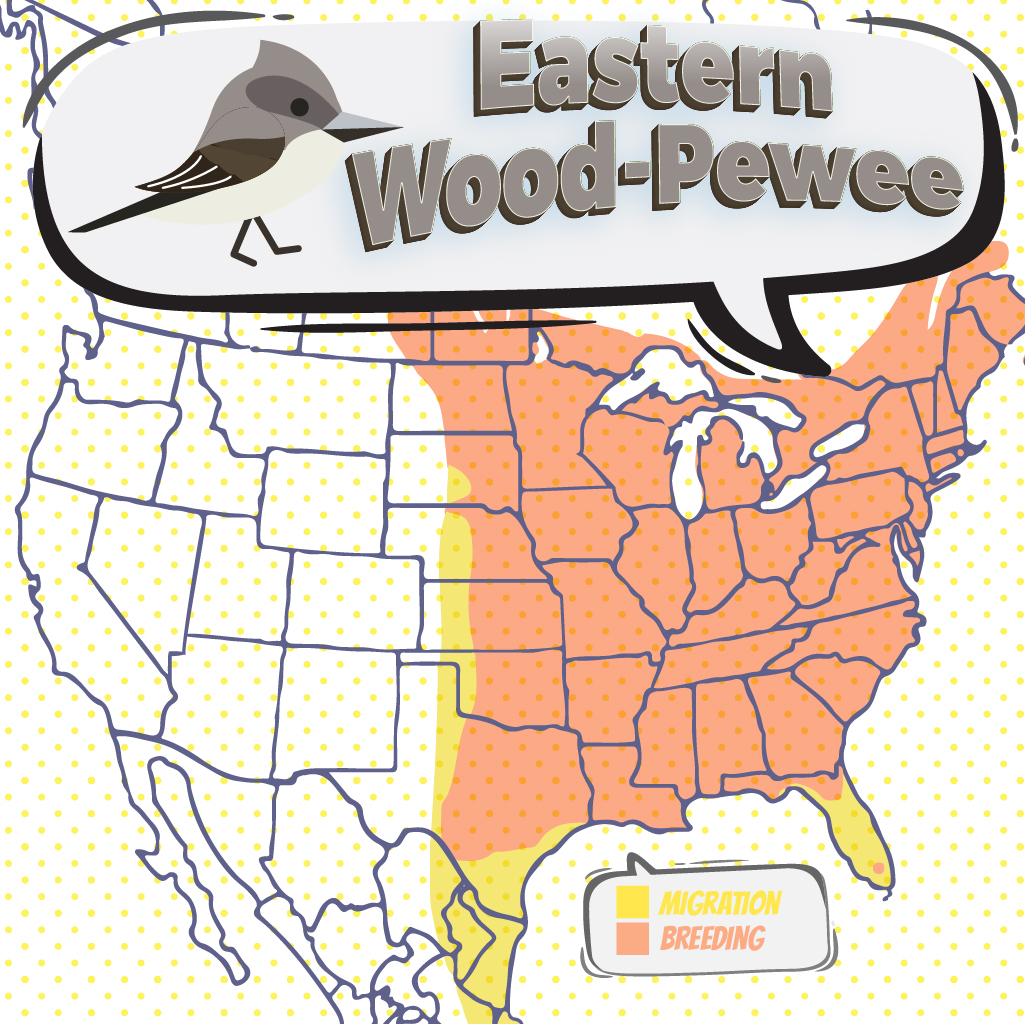
The range of Eastern Wood-Pewees goes southwards from eastern North America, into South America. Their range can extend as far as Brazil. These birds mostly breed in North America and overwinter in southern portions such as southern Peru and Brazil.
Eastern Wood-Pewee Lifecycle
Eastern Wood-Pewee males and females form pairs after arriving on the breeding grounds. Nesting can occur anytime between May and September.
These birds usually lay 3 eggs per brood. Their hatch rate at 97% is remarkable. There isn’t much information to confirm the number of broods they raise, but it has been observed that they can attempt re-nesting 4 times if previous attempts fail. Also, there’s a possibility for double brooding, although only a small portion of this species indulges in this behavior.
There isn’t enough information about their life span and the survival rates of these birds. The longest living Eastern Wood-Pewee that was documented lived till the age of 8.17 years. This bird was banded in Chestertown, Maryland. Most banded Eastern Wood-Pewees are not re-encountered by ornithologists. These birds report very minimal deaths
during migration.
Females incubate the eggs for 12-14 days, and the male feeds the female when she is incubating. Males also aggressively defend their territories.
Nesting
Only female Eastern Wood-Pewees construct the nest. This construction requires about 6 days to complete. These nests are shallow cups that are held together with fine fibers and spider webs. Lichens are used to cover the nests from outside. The material used to construct these nests is grass, moss, hair, and plant fibers. Eastern Wood-Pewees often utilize nest material that is leftover from failed nesting attempts, or successful nests.
Anatomy of an Eastern Wood-Pewee
Eastern Wood-Pewees are slender birds with medium-sized beaks. Their wings are mostly longer than other bird species in its genus.
Final Thoughts
Eastern Wood-Pewees are melodious birds that are very well known for their songs. If you’re living in America or Canada, you might not be unfamiliar with their songs. An avid birdwatcher must venture out to spot these beautiful birds and observe their special characteristics.
Ornithology
Bird Watching Academy & Camp Subscription Boxes
At Bird Watching Academy & Camp we help kids, youth, and adults get excited and involved in bird watching. We have several monthly subscription boxes that you can subscribe to. Our monthly subscription boxes help kids, youth, and adults learn about birds, bird watching, and bird conservation.
- Kids Bird Watching Monthly Subscription$10.00 / month
- Kid & Adult Bird Watching Starter Pack Subscription$10.00 / month and a $72.00 sign-up fee
- Kids Bird Watching Starter Pack Subscription$10.00 / month and a $19.00 sign-up fee
Bird Watching Binoculars for Identifying Eastern Wood-Pewee
The most common types of bird watching binoculars for viewing Eastern Wood-Pewee are 8×21 binoculars and 10×42 binoculars. Bird Watching Academy & Camp sells really nice 8×21 binoculars and 10×42 binoculars. You can view and purchase them here.
- Birding Binoculars$49.99
- Kids Binoculars$13.99
Eastern Wood-Pewee Stickers
Stickers are a great way for you to display your love for bird watching and the Eastern Wood-Pewee. We sell a monthly subscription sticker pack. The sticker packs have 12 bird stickers. These sticker packs will help your kids learn new birds every month.
Bird Feeders For Eastern Wood-Pewee
There are many types of bird feeders. Here are our favorite bird feeders for your backyard. We use all of these bird feeders currently. Kids will have a great time watching birds eat at these bird feeders. Using this collection of bird feeders will provide a wide variety and many types of birds.
Best Bird Houses for Eastern Wood-Pewee
There are many types of bird houses. Building a bird house is always fun but can be frustrating. Getting a bird house for kids to watch birds grow is always fun. If you spend a little extra money on bird houses, it will be well worth every penny and they’ll look great.




